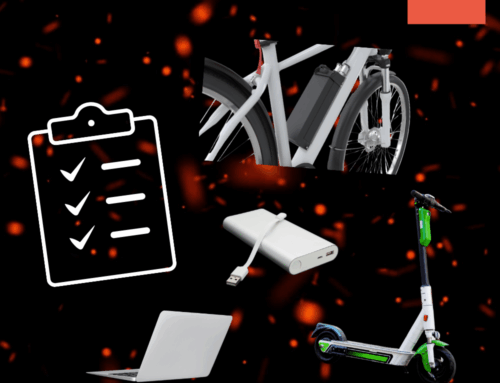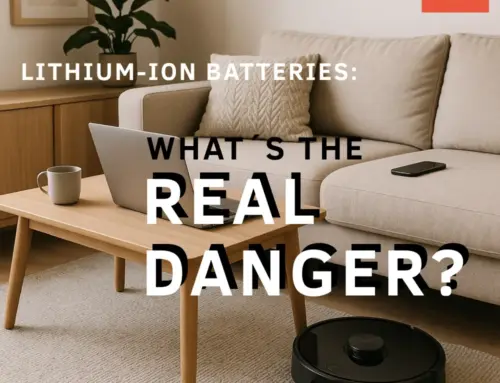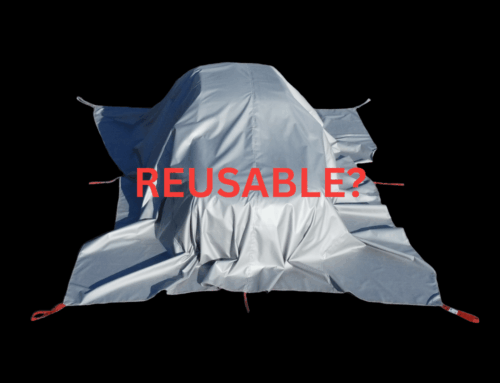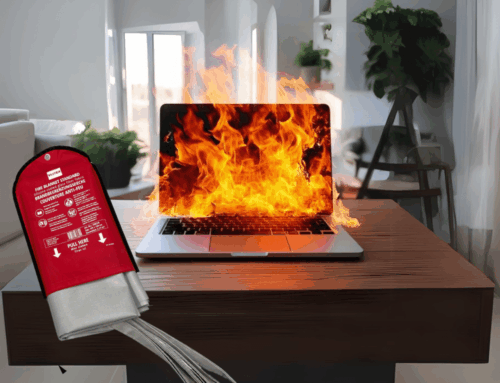
Lithium-Ionen-Akkus sind heute in fast allen elektronischen Geräten zu finden – von Smartphones über E-Bikes bis hin zu Elektrofahrzeugen. Doch was passiert, wenn ein Akku in Brand gerät?
Ein Akkubrand unterscheidet sich deutlich von herkömmlichen Bränden und stellt eine große Gefahr dar. Normale Löschmethoden wie Wasser oder herkömmliche Löschdecken sind hier oft wirkungslos. Deshalb ist es wichtig, zu wissen, wie man sich richtig verhält und welche Schutzmaßnahmen wirklich helfen.
In diesem Artikel erfahren Sie:
- Welche Ursachen Akkubrände haben
- Wie Sie im Ernstfall schnell und richtig handeln
- Warum Brandbegrenzungsdecken eine wichtige Schutzmaßnahme sind
Inhaltsverzeichnis
Wie entsteht ein Akkubrand?
Ein Lithium-Ionen-Akkubrand entsteht durch eine chemische Reaktion im Inneren der Batterie. Dies kann durch verschiedene Faktoren ausgelöst werden:
- Mechanische Beschädigung – Ein Sturz oder ein Aufprall kann die Zellstruktur des Akkus zerstören.
- Überhitzung – Zu hohe Temperaturen, etwa durch direkte Sonneneinstrahlung oder eine defekte Kühlung, können zur Entzündung führen.
- Kurzschluss – Wenn die Isolierung innerhalb des Akkus beschädigt wird, können Zellen in Kontakt treten und eine Kettenreaktion auslösen.
- Überladung oder Tiefentladung – Eine falsche Ladung kann die chemische Stabilität im Akku gefährden.
Das größte Problem: Ein brennender Akku erzeugt seine eigene Sauerstoffquelle, sodass herkömmliche Löschmethoden oft nicht ausreichen.
Erste Hilfe bei Akku-Bränden: Schritt-für-Schritt-Anleitung
1. Ruhe bewahren und Umgebung sichern
Sobald Sie bemerken, dass ein Akku überhitzt, raucht oder bereits Feuer gefangen hat, gilt es, schnell, aber besonnen zu handeln.
- Entfernen Sie sich selbst und andere Personen aus der Gefahrenzone.
- Bringen Sie das brennende Gerät soweit möglich ins Freie, um eine Ausbreitung der Flammen zu verhindern.
- Achten Sie darauf, keine brennbaren Gegenstände in der Nähe zu haben.
Achtung: Ist der Akku bereits explodiert oder stark in Brand geraten, ist es sicherer, sich zu entfernen und die Feuerwehr zu rufen.
2. Kein Wasser verwenden!
Viele Menschen greifen bei Bränden reflexartig zu Wasser – bei Akkubränden ist das jedoch oft nicht wirksam.
- Warum? Lithium-Ionen-Akkus enthalten Metalle, die mit Wasser reagieren und weitere chemische Reaktionen auslösen können.
- Wasser kann außerdem die entstehenden giftigen Gase verteilen und die Situation verschlimmern.
3. Akku mit speziellen Löschmitteln eindämmen
Normale Löschdecken oder Schaumfeuerlöscher sind bei Akkubränden oft wirkungslos. Stattdessen sollten Brandbegrenzungsdecken verwendet werden: Sie sind hitzebeständig bis zu 1.750 °C und verhindern die Brandausbreitung. Besonders für Haushalte mit vielen akkubetriebenen Geräten ist eine Brandbegrenzungsdecke eine sinnvolle Schutzmaßnahme.
4. Feuerwehr alarmieren
Sollte der Brand größer sein oder sich nicht eindämmen lassen, rufen Sie sofort die Feuerwehr.
- Machen Sie klare Angaben zur Brandursache („Lithium-Ionen-Akku brennt“).
- Falls das Gerät transportierbar ist, bringen Sie es ins Freie, aber nicht in die Nähe von Gebäuden oder Fahrzeugen.
- Bleiben Sie auf sicherem Abstand und vermeiden Sie das Einatmen des Rauchs.
Warum Brandbegrenzungsdecken eine wirksame Schutzmaßnahme sind
Herkömmliche Löschdecken können Akkubrände nicht stoppen, da sie nur die Sauerstoffzufuhr unterbrechen – doch Akkubrände erzeugen ihren eigenen Sauerstoff. Deshalb sind spezielle Brandbegrenzungsdecken die beste Wahl zur Eindämmung von Akkubränden.
Vorteile von Brandbegrenzungsdecken:
- Hitzebeständig bis 1.750 °C – normale Löschdecken halten nur bis 500 °C stand.
- Verhindern die Brandausbreitung, indem sie das Feuer eindämmen.
- Reduzieren Rauch- und Gasentwicklung, um die Umgebung zu schützen.
- Flexibel einsetzbar für Akkubrände bei E-Bikes, Werkzeugen, Laptops und anderen Geräten.
Für Privathaushalte sind Löschdecken für E-Bikes eine sinnvolle Lösung, um sich gegen Akkubrände zu schützen.
Wie können Akkubrände verhindert werden?
Auch wenn Akkubrände gefährlich sind, gibt es einige einfache Maßnahmen, um das Risiko zu minimieren:
- Nur Original-Ladegeräte verwenden: Billige oder falsche Ladegeräte können zu Überladung und Überhitzung führen.
- Nicht unbeaufsichtigt laden: Ein Akku sollte nie über Nacht oder ohne Aufsicht geladen werden.
- Akkus kühl und trocken lagern: Hohe Temperaturen oder feuchte Umgebungen können die Akkuzellen beschädigen.
- Beschädigte Akkus entsorgen: Falls ein Akku aufgebläht oder beschädigt ist, sollte er nicht mehr verwendet werden.
- Brandbegrenzungsdecke bereithalten: Besonders Haushalte mit mehreren E-Bikes oder Geräten mit Lithium-Ionen-Akkus sollten vorsorgen.
Für wissenschaftlich fundierte Empfehlungen zur Akkusicherheit bietet die Bundesanstalt für Materialforschung und -prüfung (BAM) weiterführende Informationen.
Fazit: Schnell und richtig handeln kann Leben retten
Ein Akkubrand entwickelt sich schnell und kann gefährlich werden. Wasser oder herkömmliche Löschdecken helfen hier oft nicht – stattdessen sollten Sie gezielt Maßnahmen ergreifen, um sich und andere zu schützen.
- Sofort Gefahrenbereich sichern und Akku ggf. ins Freie bringen
- Kein Wasser verwenden, sondern eine Brandbegrenzungsdecke einsetzen
- Feuerwehr alarmieren, falls der Brand nicht kontrollierbar ist
- Vorbeugende Maßnahmen treffen, um das Risiko eines Akkubrands zu minimieren
Mit diesen Erste-Hilfe-Maßnahmen sind Sie für den Notfall vorbereitet und können schnell und effektiv reagieren, falls ein Akkubrand auftritt.
Mehr erfahren
Weitere Informationen zum Brandschutz und zur richtigen Auswahl einer Brandbegrenzungsdecke finden Sie hier:








